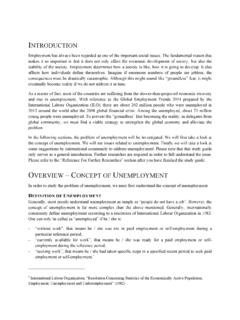Transcription of Youth population trends and sustainable development
1 May 2015 No. 2015/1 1 POPFACTS, No. 2015/1 May 2015 here were billion Youth aged 15-24 years globally in 2015, accounting for one out of every six people By 2030, the target date for the sustainable development goals, the number of Youth is projected to have grown by 7 per cent, to nearly billion. Youth can be a positive force for development when provided with the knowledge and opportunities they need to thrive. In particular, young people should acquire the education and skills needed to contribute in a productive economy, and they need access to a job market that can absorb them into its labour force. Among the greatest challenges facing many countries today are inadequate human capital investment and high unemployment rates among Youth .
2 Some countries are struggling currently to educate and employ their young people, while also anticipating substantial growth in the number of Youth . These countries will be doubly challenged in their efforts to assure universal high-quality education, productive employment and decent work for This brief summarises recent and future trends in the size of the Youth population and describes the challenges facing countries in educating and employing their Youth . 1. The size of the Youth population has peaked in all regions but Africa. In Latin America and the Caribbean, Europe, Northern America and Oceania, Youth populations have stabilized in size and are projected to change little over the coming decades (figure 1).
3 By contrast, Asia and Africa are in the midst of substantial changes in the size of their Youth populations. After rapid and sustained growth through the latter half of the 20th century, the number of young people aged 15-24 in Asia is projected to decline from 718 million in 2015 to 711 million in 2030 and 619 million in 2060. Still, Asia will be home to more Youth than any other region until around 2080, when it could be surpassed by Africa according to UN projections. In Africa, the number of Youth is growing rapidly. In 2015, 226 million Youth aged 15-24 lived in Africa, accounting for 19 per cent of the global Youth population . By 2030, it is projected that the number of Youth in Africa will have increased by 42 per cent.
4 Africa s Youth population is expected to continue to grow throughout the remainder of the 21st century, more than doubling from current levels by 2055. Data source: united nations (2013) World population Prospects: The 2012 Revision. TFigure 1: Youth aged 15-24 years, by region, 1950-2060 01002003004005006007008001950 1960 1970 1980 1990 2000 2010 2020 2030 2040 2050 2060 Youth aged 15-24 years (millions)AsiaAfricaLatin America andthe CaribbeanEuropeNorthern AmericaOceaniaYouth population trends and sustainable development 2 POPFACTS, No. 2015/1 May 2015 2. Many countries with rapidly growing Youth populations are struggling already to educate their young people. The education systems of many countries are leaving behind a substantial proportion of the population .
5 According to the most recent data available, in 32 countries, fewer than 80 per cent of 15-24 year olds are literate. Of these 32 countries, 18 are projected to see a more than 40 per cent increase in the number of Youth between 2015 and 2030. In six of these low-literacy countries, all in sub-Saharan Africa, the growth of the Youth population in this period is projected to exceed 60 per cent (figure 2). In Niger, for example, where just 24 per cent of Youth were literate in 2014, the Youth population is projected to grow by 92 per cent within the next 15 years. Angola, Burkina Faso, Chad, Mali, Nigeria, the united Republic of Tanzania and Zambia, among others, are also anticipating rapid growth of the population aged 15-24 in a context of low Youth literacy rates.
6 Inadequate investment in the health and education of young people limits their ability to reach their full productive potential and to contribute to economic development . Rapid growth in the number of Youth further compounds that challenge, requiring countries to improve the quality and reach of their education systems not only to make up for existing deficiencies, but also to serve the rapidly growing number of young people. By contrast, many countries that have experienced fertility reductions in recent decades now have an opportunity to improve the education available to their young people without needing simultaneously to serve a rapidly growing population of Youth .
7 In Pakistan, for example, where 71 per cent of the population aged 15-24 was literate in 2011, the number of Youth is projected grow by only 5 per cent between 2015 and 2030. Similarly, in Haiti, with a Youth literacy rate of 72 per cent in 2006, the Youth population is projected to increase by 7 per cent over the next 15 years. In some parts of the world, girls and young women do not have the same access to education and training as their male peers, depriving them of their rights and the ability to make decisions about their lives, including the pursuit of higher education and formal employment. Empowering women and girls and ensuring equitable investments in their human capital are essential for sustainable development .
8 Data sources: Youth population estimates and projections are from united nations (2013) World population Prospects: The 2012 Revision. Youth literacy estimates are from united nations (2014). MDG Indicators Database. Figure 2: Projected growth of the Youth population between 2015 and 2030 vs. the Youth literacy rate 3 POPFACTS, No. 2015/1 May 2015 Data sources: Youth population estimates and projections are from united nations (2013) World population Prospects: The 2012 Revision. Youth unemployment projections are from ILO (2015). World Employment and Social Outlook: trends 2015. 3. Some countries anticipating rapid growth in numbers of Youth are among those with very high Youth unemployment rates. In Jordan, Iraq and Saudi Arabia, for example, Youth unemployment rates are very high, above 30 per cent, and the Youth populations are expected to grow by more than 20 per cent over the coming 15 years (figure 3).
9 By contrast, a number of countries, such as South Africa, Spain and Greece, face extremely high Youth unemployment, with rates above 50 per cent, but are projected to see a slower growth of the Youth population , with increases around 10 per cent or less between 2015 and 2030. Even in countries where Youth unemployment rates are comparatively low, rapid growth in the number of Youth over the coming years could challenge sustainable development , if labour markets are unable to absorb rapidly increasing numbers of young workers. In Mali, for example, a large fraction of the labour force is still engaged in subsistence agriculture. Even though the Youth unemployment rate in 2015, at just under 11 per cent, is substantially lower than in many other countries, the number of Youth aged 15-24 years in 2030 is projected to be 70 per cent larger than in 2015.
10 Thus Mali s economy will need to grow to accommodate a substantially larger number of Youth seeking to enter the labour force. Similarly, Nigeria and Zambia, with Youth unemployment rates of 14 and 24 per cent respectively in 2015, are projected to see their Youth populations grow by 60 per cent over the next 15 years. If Youth are provided with sufficient education, training and jobs, then the growth in their numbers could be highly beneficial for development . If instead they are unemployed or underemployed in subsistence agriculture, the growing number of Youth will pose a challenge to the achievement of sustainable development , and could prove socially or politically destabilizing as Moreover, current unemployment among Youth impedes social and economic development not just for today but also for the future.














